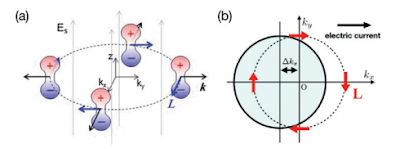Atomic orbitals and their linear combinations present elementary building blocks for electronic Bloch states in solids. Given a specific Bloch vector k, the index n of a Bloch state ψ nk carries information about two key aspects: valence orbitals of the constituent atoms and intrinsic spin of the electron. Consequently, these two aspects of Bloch states promote degrees of freedom which can be manipulated and transported for novel types of solid-state device applications. In fact, studies of the spin degree of freedom inherent to Bloch states have evolved into a prominent area of spintronics, which addresses generation, detection, and manipulation of the spin information. Similarly, one may think of the orbital degree of freedom as a variable which can be controlled in solids, referring to the respective branch of condensed matter physics as orbitronics. So far, however, orbital transport has been investigated to a much lesser degree than the spin transport. It is because the orbital degree is often regarded as “frozen” in solids: since the crystal field enforces specific symmetry of the Bloch states, this breaks the continuous rotation symmetry and suppresses the formation of the orbital moment. Thus, for elemental 3d ferromagnets (FMs), the orbital moment is much smaller than the spin moment as it requires spinorbit coupling (SOC), which is much weaker than the crystal field potential. However, exceptions exist, and it is mainly the orbital moment which contributes to magnetism in some materials.
In contrast, recent studies have shown that orbital quenching does not preclude prominent nonequilibrium dynamics and transport of the orbital degree of freedom, which is a property of the excited state rather than of the ground state. While the crystal field potential has the strongest influence on the properties of electronic states in solids, it also mediates a hybridization between different atomic orbitals, which is a crucial element in orbital dynamics. This implies that the dynamics and transport of orbital information can be driven by external stimuli, such as electric field, regardless of the orbital quenching governing the ground state. Recent studies have indeed demonstrated not only that pure orbital transport, which does not involve other (e.g., spin) currents, takes place in many materials, but also that orbital currents mediate other transport phenomena such as spin Hall effect (SHE) and valley Hall effect (VHE). Moreover, recent theories suggest that an injection of the orbital current into a FM can excite magnetization dynamics, which is one of the most important functions required for spintronic devices. This possibility has been explored in recent experiments, which demonstrated an alternative way of using the orbital current instead of the spin current in spintronics.
In this perspective, we introduce the notion of the orbital current in solids and key orbital transport phenomena, which enable an electrical generation and detection of orbital currents. We also explain and develop the idea of utilizing orbital currents and orbital injection as means to manipulate local moments in magnetic materials. Given that the experimental realization and observation of orbital effects have only recently started, we put a strong emphasis on reviewing experimental methods for the detection of the orbital currents.
In solids, electronic Bloch states are formed by atomic orbitals. While it is natural to expect that orbital composition and information about Bloch states can be manipulated and transported, in analogy to the spin degree of freedom extensively studied in past decades, it has been assumed that orbital quenching by the crystal field prevents significant dynamics of orbital degrees of freedom. However, recent studies reveal that an orbital current, given by the flow of electrons with a finite orbital angular momentum, can be electrically generated and transported in wide classes of materials despite the effect of orbital quenching in the ground state. Orbital currents also play a fundamental role in the mechanisms of other transport phenomena such as spin Hall effect and valley Hall effect. Most importantly, it has been proposed that orbital currents can be used to induce magnetization dynamics, which is one of the most pivotal and explored aspects of magnetism. Here, we give an overview of recent progress and the current status of research on orbital currents. We review proposed physical mechanisms for generating orbital currents and discuss candidate materials where orbital currents are manifest. We review recent experiments on orbital current generation and transport and discuss various experimental methods to quantify this elusive object at the heart of orbitronics —an area which exploits the orbital degree of freedom as an information carrier in solid-state devices.
Fig. 1: (a) A mechanism of the ORE. An electric dipole moment ∼ L × k couples to a surface electric field Es. (b) OEE in the presence of a chiral OAM texture in k-space.
Fig. 2: Mechanism of the OT in a NM/FM bilayer. The OHE in the NM results in the orbital injection (red arrow) into the FM, where it couples to spin (blue arrow) via SOC. Thus, spin-orbit entangled states exert a torque on the magnetization.
Fig. 3: (a) The k-space OAM texture in a surface-oxidized Cu film at the Fermi surface. (b) The OT in a CuOx/Pt/TmIG structure, where the OAM induced by the OEE (blue circular loops) strongly couples to the spin (red arrows) in an ultrathin Pt layer, which ultimately exerts a torque on the magnetic moment of TmIG (yellow arrows).
Conclusion
As the field of orbital transport is in its infancy, fundamental physical principles and novel transport effects await to be discovered. One of the most important tasks is to establish clear characterization tools in experiments. To date, no transport measurement scheme to detect the orbital currents, which does not involve spin currents, has been developed. While Xiao et al. proposed a magnetoresistance measurement with a FM lead for the detection of the OHE, it requires the SOC for the orbital-to-spin conversion, which is hard to disentangle from the signal by the SHE. One of the main problems here is that no “orbital polarizer”, which plays a role of a FM for the spin current, is known.
Another important phenomenon that needs to be addressed is the relaxation and dephasing of the orbital current. So far, there is no consensus on how far the orbital current can travel in different systems and setups and which microscopic processes lead to orbital relaxation. A recent theory suggests that the orbital current can propagate over much longer distances than the spin current in FMs, whose dephasing mechanism is completely different from that of the spin current. Interestingly, recent magnetoresistance measurements in CuOx/Py found that the dephasing length extracted by assuming the spin current model is much longer than the known value in Py. Considering that the orbital current is expected to be efficiently generated at the interface of CuOx, the result suggests that the orbital current is absorbed more slowly than the spin current in FMs.
Considering the interaction of electrons with other quasi-particles, one of the exciting directions to pursue lies with effects due to interaction of orbital currents with phonons and magnons. We remark that phononic analog of the OHE has been theoretically proposed recently, and various mechanisms for inducing phonon OAM are being actively investigated. In magnonics, it was suggested that the magnon Hall effect can be orbitally polarized via spin excitations which carry spin chirality, with the magnon current “dragging” the electronic OAM. Also, a concept of magnonic OAM was proposed recently. We remark that there exists an elementary excitation of orbital wave in an orbitally ordered state, and such “orbitons” were measured LaMnO3. We believe that studying orbital transport effects in transition metal oxides with orbital ordering may shed new light on the orbital physics and correlated phenomena.
To summarize, the orbital current holds promises for new types of transport effects, which may possibly lead to new types of device applications that employ the orbital degree of freedom as an information carrier. The field is evolving rapidly in part due to an intensive interaction with neighboring research areas such as phononics, spintronics and valleytronics, where the orbital current provides new twists and solutions to existing problems with spin and valley currents. We look forward to further explorations in this exciting area of physics in the near future.





















